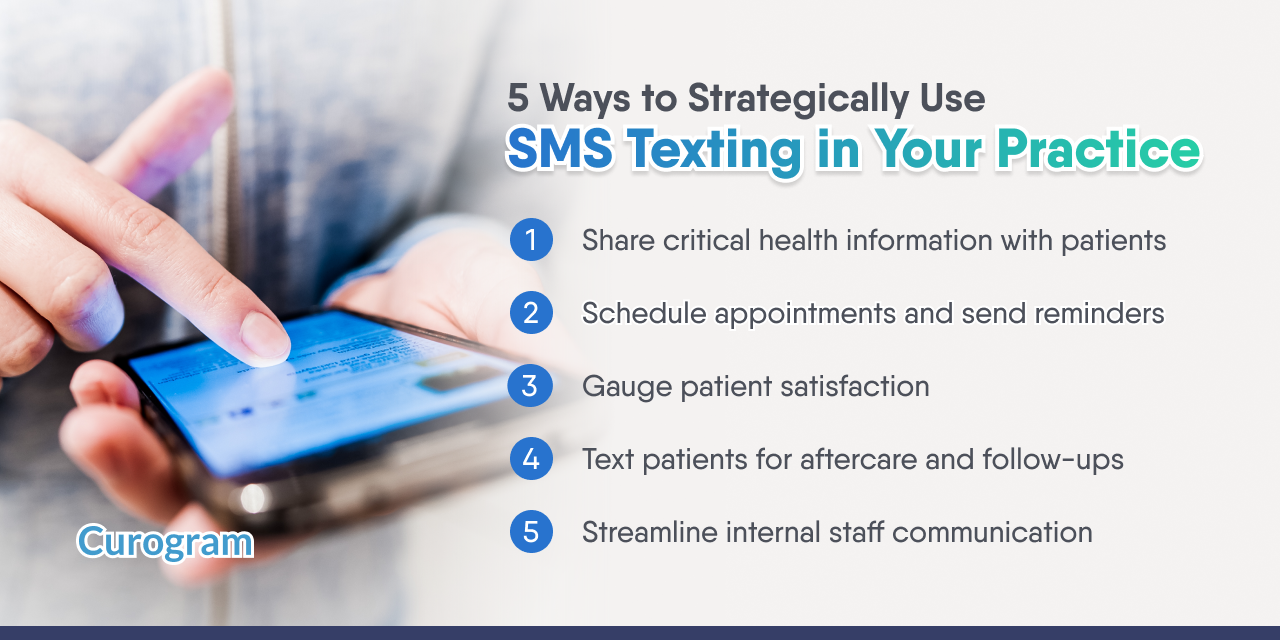Text Messaging Improves Patient Satisfaction and Practice Revenue
In a demanding and competitive industry, businesses like your medical practice must consistently balance tasks to improve patient satisfaction while...
3 min read
 Carylee Gali
:
11/21/22 6:26 PM
Carylee Gali
:
11/21/22 6:26 PM

Enhanced patient communication makes a difference in providing good healthcare and excellent healthcare. That is why more medical practices leverage text messaging (SMS) to provide their patients with the easiest and most convenient way to reach out to them and vice versa.
Instant communication between physicians and patients is essential in every medical practice. Text messaging has become a primary communication tool not only to enhance patient communication but to streamline the workforce and increase profits.
To make the most of text messaging, here are five ways you can use it in your medical practice.
Perhaps the most common use of text messaging in every medical practice is communicating with patients. Sending SMS is a great and easy way to share health information or make important announcements about your services. Patients appreciate receiving text messages from their healthcare providers, whom they rely on for crucial health information.
Sending a mass message to your patients can dramatically improve patient communication and satisfaction, as well as health outcomes. Texting health tips encourages and assists patients in leading a healthier lifestyle. You can also send texts to inform patients about your office hours during the holidays, billing policy, etc.
People nowadays tend to ignore phone calls or voicemail messages; they prefer more direct and hassle-free communication such as texting. With texting, people don’t have to answer a call, write down a message, or listen to anything, and patients love this.
Many medical practices have moved toward integrating text messaging into their scheduling system for faster and more efficient transactions, such as appointment booking.
With 2-way texting, your patients can easily schedule their appointments, and you can notify them with appointment reminders to prevent patient no-shows or cancellations. If patients want to reschedule, make it easier for them and send a follow-up text message with details about rescheduling the appointment.
By implementing a text messaging solution, medical practices guarantee that patients receive and see the text message about their scheduled appointment, significantly reducing missed appointments.
Asking patients to leave online reviews can be challenging because some patients may feel hesitant to provide face-to-face feedback. But with texting, your medical practice can get more positive patient reviews or five-star ratings to help boost your business rating.
You can request reviews from your patients by texting them the link to your website or Google business profile. A text message asking for a review may look something like this:
“Hi, Andrea. This is [staff name] from [clinic’s name]. We would like to know how you feel after your appointment with Dr. Lewis? We would highly appreciate it if you could leave your feedback on our website. Simply click this link [hyperlink your website]. Thank you, and have a nice day!”
Since receiving negative reviews is unavoidable, 2-way texting messaging platforms like Curogram can intercept negative feedback before it’s published. That allows your practice to resolve an issue privately before it gets out on the internet and potential patients view it.
Healthcare is ultimately about patients, regardless of whether they are in a hospital or not. Medical practices send text messages to patients after their appointments or treatments to make sure they are coping fine and well taken care of.
Texting allows your patients or their caregivers to reach out to you if they have follow-up questions or complications after a visit to the hospital.
You and your staff can text patients to remind them to adhere to the prescribed medication or post-treatment care recommendations. Texting instructions is one way to help patients take their medication correctly and avoid complications.
Consider sending the following text messages:
Make sure to tell your patients to reply to your reminder texts to confirm that they receive them. If there is no reply from the patient, medical staff can reach out to engage with them.
Texting is a quick way to communicate and get answers from your staff. You can send SMS to give your staff updates on sudden changes in their work schedule and remind them about corporate events or training. You can also reach them during an emergency like natural disasters or accidents to ensure they are safe.
People read 95% of text messages within three minutes of being sent. Healthcare providers take advantage of this response rate to ensure that there are no gaps in staff communication and no delay in providing the care that patients need.
More importantly, you may transform repetitive tasks such as confirming appointment bookings and appointment reminders into automated text messages so your staff can focus on more crucial clinical tasks.
You can do all text messaging on a HIPAA-compliant platform like Curogram.
Texting becomes normal once your medical practice establishes a good relationship with your patients. The use of texting allows your medical practice to communicate more effectively with patients and staff, manage patient feedback, enhance health outcomes, and prevent patient no-shows, increasing your revenue.
However, if you consider using a text messaging service in your practice, you must review the Health Insurance Portability and Accountability Act (HIPAA) to ensure compliance.
While there are clear advantages to allowing text messaging in your medical practice, it is not without risks. Quick and simple as it is, 2-way texting is also the easiest way for healthcare providers to violate privacy laws regarding exchanging sensitive health information in an unsecured communication channel. You and your team must treat text messaging with patients differently from regular texting to avoid HIPAA violations, especially in disclosing protected health information (PHI).
Curogram’s closed-protected system with full end-to-end encryption only allows authorized individuals to send and receive messages. Curogram fully adheres to HIPAA texting guidelines. If you want to use text messaging in your medical practice, Curogram is an excellent choice that can manage all the possibilities SMS offers.


In a demanding and competitive industry, businesses like your medical practice must consistently balance tasks to improve patient satisfaction while...

Texting has long stood as a reliable tool for bolstering patient relationships and smoothing day-to-day operations. While we’re all familiar with...

Text messaging (SMS) should become a staple of every modern medical practice. Patients want to text their healthcare providers, as it’s more...